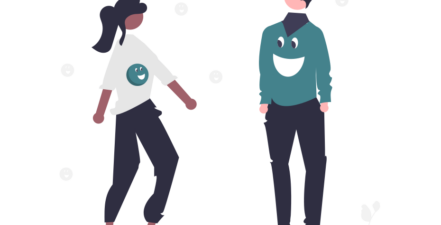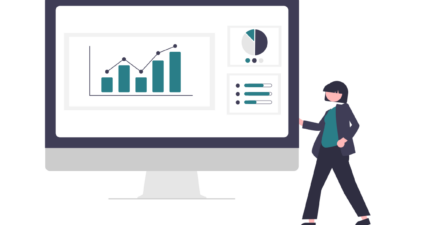Guide to Stakeholder Analysis

Curious about stakeholder analysis — what it is, why bother with it, and how you actually do it? Confused by all the info out there and want it broken down in easy-to-understand terms?
This Super Simple Guide to Stakeholder Analysis will equip you with the basic definitions and concepts, as well as touching on more advanced ideas (for when you’re ready to dive deeper).
You’re in the perfect place if you’re a stakeholder industry newbie. But if you work with stakeholders in any capacity (including project managers, communications managers, and executives), this guide will help to build on what you already know and challenge you to up your stakeholder analysis game.
Let’s start with the definitions…
Stakeholder Analysis Definitions
Who are Stakeholders?
Stakeholders include any people or groups involved in (or impacted by) a project, organization, or action. Some common examples of stakeholders include employees, shareholders, customers, government bodies, members of the public, businesses, and regulatory bodies.
Learn more: What Does Stakeholder Mean?
What is Stakeholder Analysis?
Stakeholder analysis involves identifying who your stakeholders are, working to understand their interest in and influence on the project, how your project or work will affect them, and grouping them based on this understanding.
What Isn’t Stakeholder Analysis?
We’ve talked about what stakeholder analysis is, but what are some common misconceptions about it? What isn’t it?
Although you may use some data to conduct your stakeholder analysis and the phrasing may sound similar, the practice of analyzing stakeholders has very little to do with analytics.
Another misconception is that stakeholder analysis works as a standalone process. But it is just one (very important) part of the overall stakeholder process. What really matters is applying the insights you gain so that you can better engage with, consult with, and manage your stakeholders.
Finally, stakeholder analysis is not a one and done process. As your stakeholders, project, and environment shift, you may need to revisit your analysis.
What is ‘Interest’?
The concept of “interest” is more than an idea of how interesting your project is to the stakeholder, or how interested they are in being involved. Think of “interest” in more of a legal sense of a right to be involved or consulted. For an infrastructure project this may be legal rights such as a lease or property ownership, or even just regular use of a site. There could also be cultural, social and historical connections with the area, particularly with First Nations groups, which also confers an “interest” in that area.
Become a Subscriber Don’t miss out on more insights like this! Subscribe to get our regular updates.
What is ‘Influence’?
Each stakeholder has a different level of influence on a project, depending on their ability to impact the process and outcomes. In some projects, influence may also be referred to as “power” — though they are not exactly the same thing.
What is ‘Impact’?
Each stakeholder may be impacted by the project in different ways — positively, negatively, or a mixture of both. There could be direct impacts such as on their livelihood or ability to work (such as restrictions on access to fishing areas), or on the property they own (such as land acquisition or resettlement). It’s important to consider all impacts a project or work can have on stakeholders, including physical, economic, social and cultural.
Why Should You Do Stakeholder Analysis?
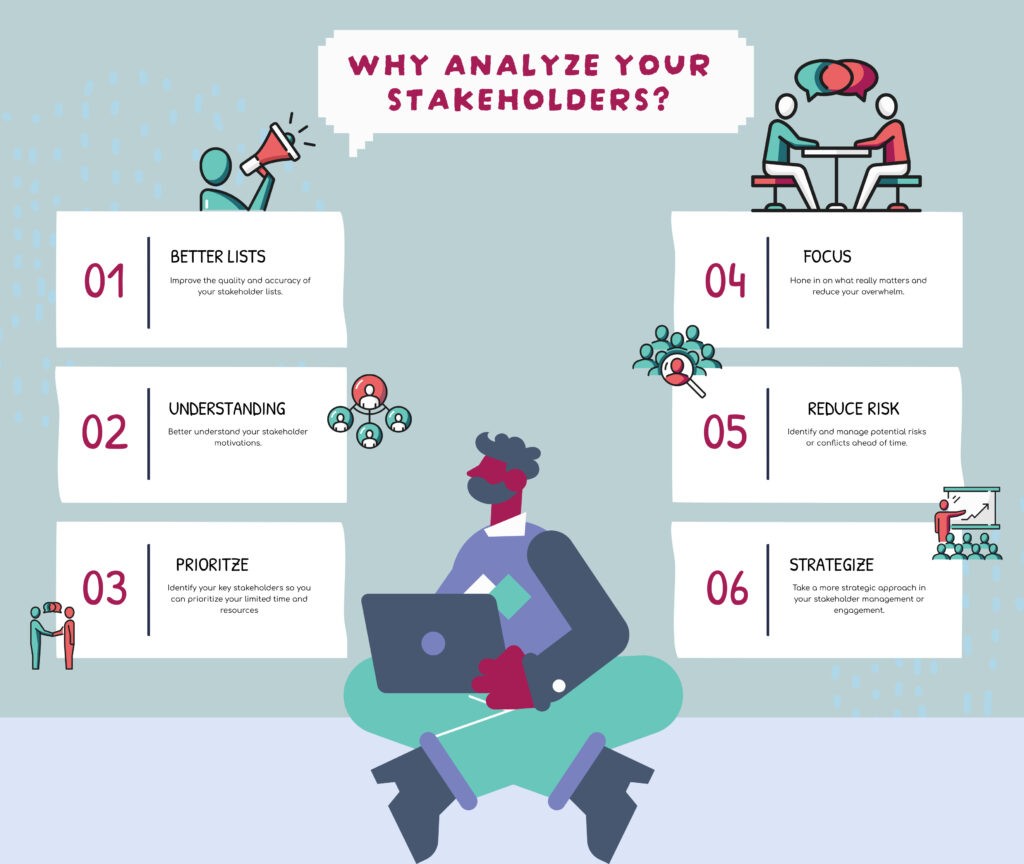
Curious about the importance of stakeholder analysis? Stakeholder analysis is the logical first step in your stakeholder management or engagement process. Here’s what identifying, understanding, and organizing your stakeholders can help you do…
1. Improve the Quality and Accuracy of Stakeholder Lists
How successful you are likely to be with managing stakeholders rests heavily on your stakeholder lists. If they’re not accurate or up-to-date, you’re essentially flying blind.
Analyzing your stakeholders can help you spot gaps and figure out who’s missing. Plus, it’s the perfect time to improve your stakeholder lists by moving them into a stakeholder management tool, cleaning up duplicates, and updating contact info.
2. Understand Stakeholder Motivations
What makes people think and act a certain way? Is it their political or religious beliefs? Their values and demographics? Through stakeholder analysis, you can gain new insights into people’s motivations that allow you to tailor your communication, focus areas, and stakeholder activities so that they’re more meaningful and effective.
3. Know What Areas to Focus On
Chances are, you’re looking at a long list of issues that could be relevant to your stakeholders. It may not be practical to tackle every issue in your communication and engagement strategy — certainly not all at once. Stakeholder analysis can help you uncover which issues are the most important (and to whom) so that you can focus on these first.
For example, you might find out that key stakeholders care a lot about environmental impacts of the work you’re doingt. Talking more about your organization’s efforts to mitigate the environmental impact of a project could be a good focus area in order to build social license to operate.
4. Identify Your Key Stakeholders
The stakeholder analysis process can help you identify who you need to pay the most attention to. Your key stakeholders are those with greater interest and/or greater influence, and it may be critical to get their input on the project, keep them informed more regularly, and build social capital.
We share more about this in our article on identifying and prioritizing stakeholders.
5. Reduce Overwhelm
If you’re looking at a list of thousands stakeholders, it can quickly get overwhelming. Where do you start? Who do you start with?
Stakeholder analysis helps to break the list down into smaller, more manageable groups. This can make it much easier to develop engagement and communication strategies tailored to the needs and interests of each group.
6. Prioritize Limited Time and Resources
Limited time and resources are one of the main challenges for stakeholder professionals and project managers. If you only have 10 hours each week to devote to the project, how can you really make an impact if you have to split that time between so many people?
It’s probably not realistic to speak to everyone individually. But analyzing your stakeholders will help you organize them into groups, better prioritize your resources, and may even free up your time to give individualized attention to a handful of key stakeholders.
7. Build a Case for More Resources
Stakeholder analysis can help you demonstrate the resources needed to manage or engage your stakeholders. You’ll be able to show the number of stakeholders, the different groups involved, and the potential impacts of stakeholders (both positive and negative) if managed properly.
Stakeholder Analysis Methods
Stakeholder maps can be a useful tool for stakeholder analysis because they help to visualize stakeholders based on their attributes and how they relate to the work you’re doing.
Some of the more traditionally used stakeholder mapping models include:
- The Salience Model – Each stakeholder is assigned a level of power, legitimacy, and urgency to determine their priority
- The Stakeholder Knowledge Base Chart – Stakeholders are mapped on a quadrant based on their level of awareness and whether they support or oppose the project or work
- The Power/Interest Grid – Each stakeholder is mapped on a quadrant based on their degree of power and level of interest
- The Power-Predictability Matrix – Each stakeholders is mapped on a quadrant based on their degree of power and how predictable they’re likely to be
But just because the above models are often used doesn’t mean they’re the best way to map stakeholders. In fact, there are some problems with the historical approach to stakeholder mapping.
We share more about different stakeholder mapping approaches in our blog on stakeholder mapping, but to sum it up, there are three main issues.
Firstly, these models are dated, as power is no longer centrally held. Now, low influence stakeholders can become a very strong force if they network together — something which is easier to do than ever thanks to social media platforms.
And secondly, the language used to describe people in some of the older models is best left in the previous century.
Finally, most of these models only focus on a very limited subset of stakeholder attributes. This makes them quite flat and two-dimensional, which really limits what you can analyze and visualize.
Fortunately, there are other options…
Modern Stakeholder Mapping Approaches
Multidimensional Stakeholder Mapping
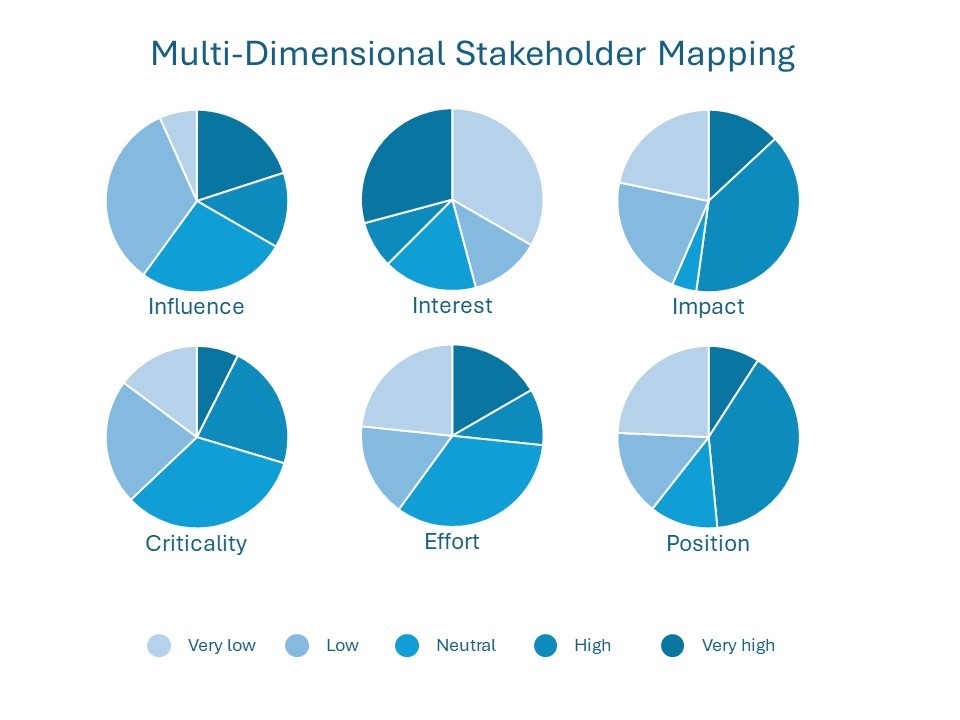
Simply Stakeholders has a new and better way of doing stakeholder mapping. We use Multidimensional Stakeholder Mapping based on 6 highly relevant criteria:
- Influence – What level of influence does the stakeholder have over the project? (from very low to very high)
- Interest – What level of interest does the stakeholder have in the project? (from very low to very high)
- Impact – To what degree is the stakeholder likely to be impacted by the project? (from very low to very high)
- Criticality – How critical is the stakeholder to the desired outcomes of the project? (from very low to very high)
- Effort – What level of effort is required to engage with this stakeholder? (from very low to very high)
- Position – What is the stakeholder’s position towards the project? (from very negative to very positive)
Note: we used to refer to this as the Three I’s Method before increasing our criteria from 3 to 6!
Inside our software, users can track both engagements and Contact Groups based on the above attributes to strategically plan an engagement, prioritize actions, and track progress towards goals.
Relationship Mapping
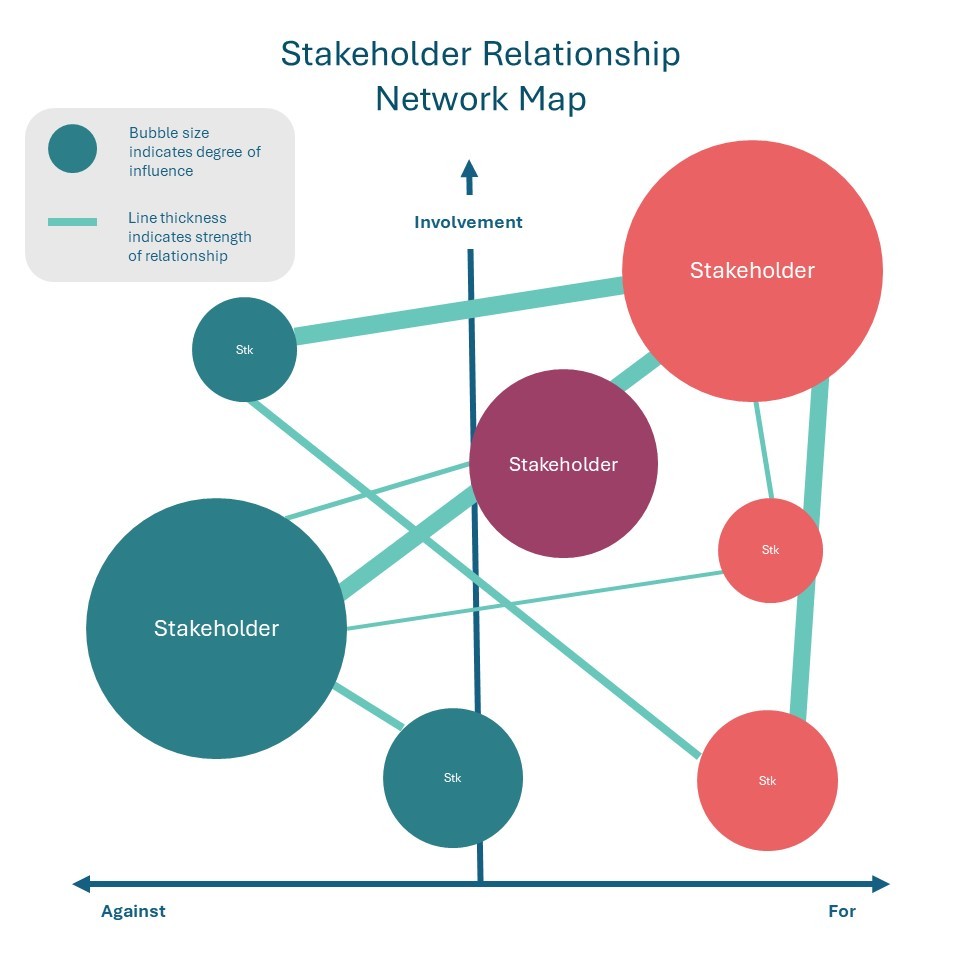
Another type of modern stakeholder mapping built into Simply Stakeholders is stakeholder network maps. This is a bit like mindmapping for stakeholder relationships — you can see who is connected to whom within your organization, between your stakeholders and your organization, and between stakeholders themselves. But with different colors, shapes, and sizes, you can also display other attributes and information about your stakeholders and relationships, like:
- Direction of influence
- Level of influence/impact of a stakeholder
- Type of stakeholder
- Strength of relationship
- Level of involvement
- Sentiment or support
Being able to visualize this kind of information is incredibly valuable for planning your stakeholder engagements, strategically approaching your relationships, and reporting on your progress. Learn more about relationship mapping and stakeholder relationship networks — you’ll definitely want to add these to your toolkit!
Stakeholder Sentiment Analysis
We also track stakeholder sentiment inside Simply Stakeholders. Although this isn’t strictly stakeholder mapping, it can provide valuable context alongside your stakeholder maps.
A stakeholder sentiment analysis can help you understand your stakeholder’s emotions. Are they feeling positively or negatively towards the project or a particular issue? How is that sentiment changing over time? You can analyze sentiment by looking at the tone and words stakeholders use in survey responses, call recordings, emails, and other communication.
We talk more about this in our blog on 5 simple steps to getting started with stakeholder data management.
|
How Do You Do Stakeholder Analysis?
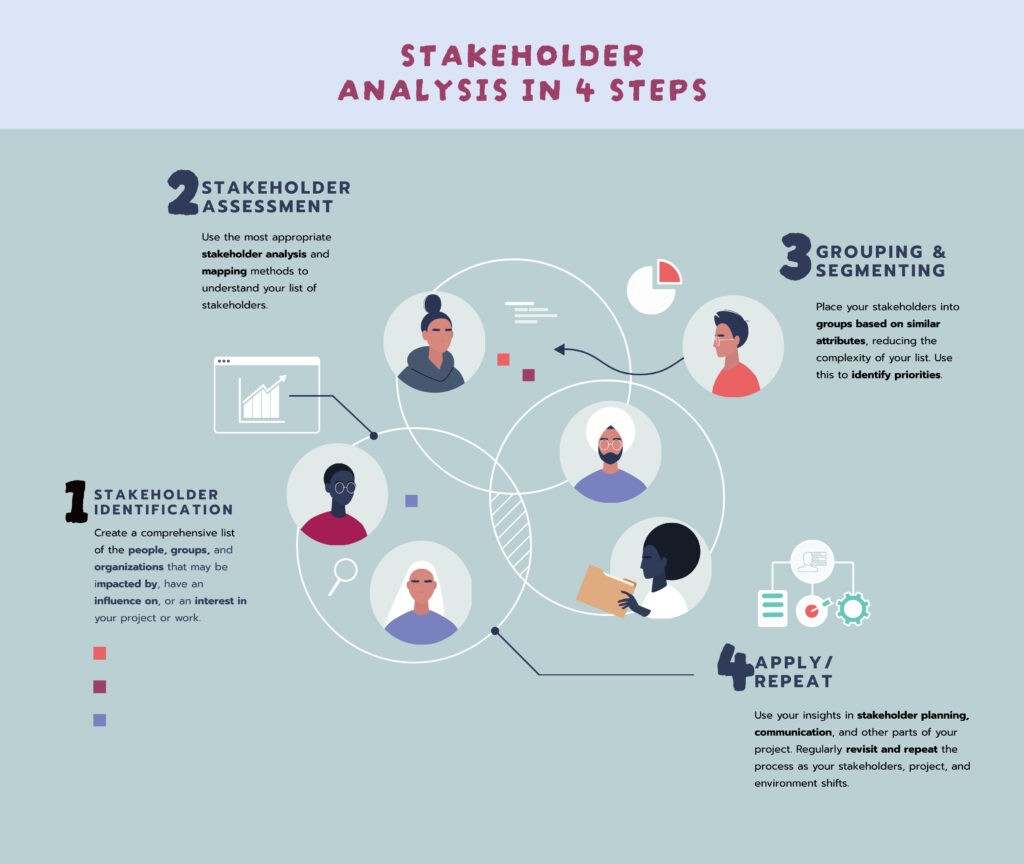
Step 1: Stakeholder Identification
Before you can analyze your stakeholders, you need to know who they are. Start with your existing list (if you have one) and do some brainstorming to see who might be missing.
Mind mapping software or a good, old-fashioned on a whiteboard can be a helpful exercise here. It’s also worth talking to a variety of people in your organization to find out what groups and individuals they deal with, as well as those they expect to come across throughout the project or work. The more perspectives you get, the less likely you’ll miss someone.
Remember: your stakeholders are any individuals or groups who might impact your project or be impacted by it. Plus, anyone you’re required to consult with.
|
Step 2: Stakeholder Assessment
Once you’ve identified all your stakeholders, it’s time to assess and analyze them. The stakeholder assessment process you use here will depend on which stakeholder mapping method you choose to work with. But you’ll likely look at their interest, impact, power, attitudes, and other attributes.
|
It can take some time to assess each stakeholder, especially if you need to work through a long list of contacts. But it’s worth doing this step properly, as it will set you up for the next step. Plus, it’ll enable you to effectively tailor (and prioritize) your stakeholder management approach, communication, and engagement activities.
Step 3: Stakeholder Grouping
After you’ve finished stakeholder mapping, you’ll notice that some stakeholders have similar attributes. These stakeholders can be grouped together (or segmented!), reducing the complexity of your stakeholder list while enabling you to tailor your approach to meet each stakeholders’ needs.
This process will also help you identify which priorities to focus on first, based on the top concerns of your key stakeholders.
Step 4: Apply Insights & Repeat
Next it’s time to bring your insights into your other processes. This might mean your stakeholder engagement/management plan, communication, or other parts of your project or work.
And then repeat the process regularly. After all, stakeholder lists are not static. Your individual stakeholders and groups will shift over time, along with their attributes, interest, influence, sentiment, and more. It’s a good idea to regularly analyze your list and adjust your stakeholder planning and activities accordingly — especially for longer projects and pieces of work.
|
Plus, this can help you monitor how your stakeholders change over time in response to communication, engagement, project changes, and the environment. You can use these insights to understand how well you’re doing while there’s still an opportunity to impact the outcome.
How to Use Stakeholder Analysis
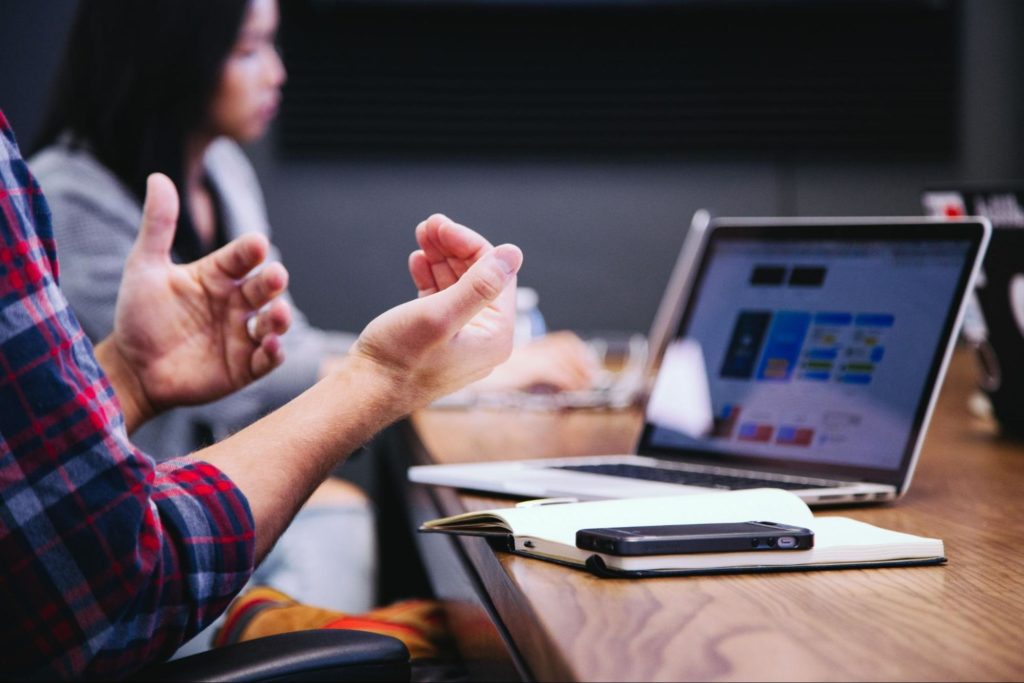
You can gain a lot of insights from analyzing stakeholders, including who you should focus on, how to best work with them, when (and how often) to interact with them, and what issues you need to focus on. These insights can be used in many different ways, like…
Creating a Stakeholder Plan
Stakeholder analysis is the first step in every good stakeholder plan because you can only identify appropriate strategies after you know who your stakeholders are.
Want to learn more about stakeholder planning, including the other steps? Download our free eBook on how to create a stakeholder management plan.
Stakeholder Management
Stakeholder management is an umbrella term that encompasses a range of methods and approaches to managing, monitoring, and interacting with stakeholders.
Stakeholder analysis can help you understand who you’re managing, the most effective ways to manage them, and what areas might need closer monitoring.
Public Participation
Public participation is also known as public involvement or citizen participation. This approach to stakeholder management facilitates an environment where members of the public (who are impacted by or interested in a decision) are involved in the process.
Stakeholder analysis can help to support accountability in public participation. For example, it can help you identify who makes up ‘the public’ so that you can work towards getting balanced participation across all groups.
Stakeholder Engagement
Stakeholder engagement is focused on building relationships with stakeholders — including both internal engagement and external engagement. The goal of engagement is to get stakeholder support and/or benefit from their perspectives.
Like other approaches, analysis forms the first step in a stakeholder engagement plan. It can help you identify stakeholders’ degree of interest/influence, and which stakeholders you need input from on different issues (getting clear on this as early in the process as possible).
Creating a Communication Plan
Stakeholder analysis often forms part of a communication plan. It can reveal useful insights into who you need to communicate with, including:
- What issues they want to hear about the most
- Sensitive issues to avoid or approach with greater care
- Knowledge gaps and stakeholders that could benefit from additional information
- What platforms/mediums are best for reaching each group
- How often you need to communicate with different groups
Project Management
Since stakeholder management forms a major part of project management, project managers can benefit from analyzing their stakeholders before the work begins. Stakeholder analysis is especially useful for identifying stakeholders you may have otherwise missed. And it can help to identify potential issues and opportunities early on — for example, a manager who isn’t on board with the project, or a champion for change who can help to influence others.
3 Stakeholder Analysis Examples
Perhaps the best way to truly explain stakeholder analysis is to illustrate it with some examples. So, let’s break down why you might conduct stakeholder analysis and what methods you might use across four different scenarios.
Stakeholder Analysis for a New Wind Farm
Let’s say a company is looking to install a new offshore wind farm off the coast. Stakeholder analysis would be important for this project to understand who the stakeholders are, which stakeholders are more critical to engage with, anticipate various risks/objections to the project, and hopefully increase local support for any changes that need to take place. For this project, stakeholder analysis could look something like this:
| 1. Stakeholder Identification |
Potential stakeholders might come from any of the following groups:
|
| 2. Stakeholder Assessment
Interest, Impact, Power, Attitudes, etc. |
An assessment might reveal that certain stakeholders (especially nearby residents and local business users within the farm area) were likely to see a high impact on the project and may feel negatively towards it.
Some environmental groups may feel negatively and others positively — depending on their perspectives and goals. Suppliers and collaborators may have a significant impact on the project outcomes. Meanwhile, other stakeholders (members of the public, energy users, and the fossil fuel industry) may have less of an impact on the project — but still be interested in it. Relationship network mapping may reveal that certain stakeholders within any of these groups are more connected and influential than others.
|
| 3: Stakeholder Grouping
By priority, shared interests, similar attributes, etc. |
Depending on the outcomes of the stakeholder assessment, the project managers may group the stakeholders by priority (and communication frequency).
|
| 4. Apply the Insights
Use in stakeholder planning, activities, and reporting |
Priority 1 stakeholders should be offered a variety of engagement methods to increase their participation. This may include face-to-face visits, events, phone calls, and individual interviews.
Priority 2 stakeholders should be offered regular engagement opportunities, such as events, surveys, updates, and more. Other stakeholders may be offered regular updates via email or SMS, as well as opportunities to provide feedback via surveys.
|
Learn more about this area in our blog on Who are the Stakeholders in Offshore Wind Energy Projects?
Stakeholder Analysis for a New Highway Development
Stakeholder analysis will likely be a critical step (and ongoing necessity) for the new Caboolture West / Waraba development in South-East Queensland — especially with the planned Bruce Highway Western Alternative.
The stakes are high when it comes to major developments like this, with many varying levels of impact, influence, and competing interests. Stakeholder analysis can help with anticipating objections, managing expectations, minimizing risk, and ensuring the smoothest possible path to project completion. Here’s what we imagine that process might look like:
| 1. Stakeholder Identification |
Potential stakeholders might come from any of the following groups:
|
| 2. Stakeholder Assessment
Interest, Impact, Power, Attitudes, etc. |
From an assessment, you might discover that the groups most impacted are the local residents, homeowners, and farmers whose land may be purchased to make way for the development — and those who might find themselves living on a main road.
But any local businesses, schools, and facilities may find their services disrupted due to the development. At this point, it’s also critical to note down any groups that may be particularly disadvantaged and marginalised.
|
| 3: Stakeholder Grouping
By priority, shared interests, similar attributes, etc. |
Depending on the outcomes of the stakeholder assessment, the local council may group the stakeholders by the type of communication they may need to receive and the level of participation required.
|
| 4. Apply the Insights
Use in stakeholder planning, activities, and reporting |
Priority 1 stakeholders will need to be consulted with early and often — taking into account the potential impacts and minimizing these where possible.
Priority 2 stakeholders will need to be informed about any disruptions to their commute and business, and encouraged to provide feedback about the route. Other stakeholders will mainly need to be kept informed, but may also benefit from some involvement in the process to help inform decision-making.
|
Stakeholder Analysis for Government Policy Change
Stakeholder analysis is an important tool for policy making that can play a role in successful implementation. Policymakers must identify the stakeholders in relation to a policy — along with their interests, importance, and potential knowledge. In some cases consultation may even be required in order to create or change policy. But in any case, beginning with stakeholder analysis can help to anticipate and avoid potential misunderstanding and opposition.
| 1. Stakeholder Identification |
Potential stakeholders might come from any of the following groups:
Plus, any groups that the policy might directly impact. For instance, health policy might impact patients, sick people, carers, and insurers. Housing policy may impact landlords, renters, investors, real estate companies, and banks. Economic policy would likely impact businesses, investors, and taxpayers — some more than others. Education policy may impact teachers, students, and parents — and future employers.
|
| 2. Stakeholder Assessment
Interest, Impact, Power, Attitudes, etc. |
Assessing stakeholders would soon reveal the different stakeholder perspectives on the proposed program or policy, including who it impacts, who may influence it, and differing interests and attitudes.
Most of the time, a policy change will have “winners” and “losers” and the assessment should make it possible to identify who these might be.
|
| 3: Stakeholder Grouping
By priority, shared interests, similar attributes, etc. |
Grouping policy stakeholders might happen depending on the level of involvement you expect, for instance, inform, consult, involve, collaborate, or empower. Or you may group them based on shared interests — as these groups will likely need to receive similar information and opportunities to engage.
|
| 4. Apply the InsightsUse in stakeholder planning, activities, and reporting | Whatever insights you gained from the stakeholder analysis process, these should be used to plan the policy or program, and the corresponding engagement activities.
|
Learn more on this topic in our previous blogs, 4 Examples of Stakeholder Engagement In Policy and Policy Consultation & the Importance of Stakeholders.
Common Mistakes with Stakeholder Analysis
Want to avoid the common mistakes? Our team has been in the stakeholder management industry for several decades now. In that time, we’ve found that organizations consistently trip up with their stakeholder analysis in the following areas:
1. Only Doing Stakeholder Analysis at the Start
While starting with stakeholder analysis is a smart move, it’s important to revisit your stakeholder list regularly to keep it updated and monitor for change.
2. Only Using One Stakeholder Mapping Method
While the Power/Interest Grid is a popular method, it’s not a perfect framework. It’s a good idea to use multiple methods to give you a more complete analysis of your stakeholders (check out our article covering 15 different stakeholder diagrams if you’d like some ideas or inspiration!).
We’re fans of the multidimensional stakeholder mapping method: Interest, Influence, Impact, Criticality, Effort, and Position.
3. Not Assigning Resources
Depending on the complexity of your project and volume of stakeholders, it can take significant resources to properly analyze stakeholders. Too many teams don’t set aside enough time or suitable software to support the process. Software like Simply Stakeholders can help reduce the amount of time that goes into analyzing stakeholders upfront — as well as making it easy to update the insights throughout the engagement.
Learn more in our article on 6 Ways Stakeholder Management Software Delivers ROI.
4. Not Analyzing Stakeholders as a Team
If you work as a team but assign stakeholder analysis to one individual team member, you’re missing valuable opportunities to incorporate everyone’s insights into the analyses. On top of this, you forego the chance to get everyone on the same page and have conversations about how important and influential your stakeholders really are — and these insights should influence the direction of your project.
5. Not Using the Insights
Identifying and mapping your stakeholders is a useful exercise that requires time and effort. So maximize the value you get from the insights by using them to shape discussions and develop plans, strategies, and reports.
See more details in our blog on stakeholder analysis mistakes.
Introduction to Advanced Stakeholder Analysis Concepts
We’ve kept this guide super simple, but if you’re looking to expand your knowledge with more advanced concepts and ideas, you might like to explore the following topics.
Stakeholder Relationship Mapping
While we looked at mapping stakeholders based on their attributes, we haven’t discussed stakeholder relationships in great detail. Stakeholder relationships are an important consideration for your stakeholder analysis — when you know who you’re connected to and who they’re connected to, you can make more strategic decisions that help you more effectively engage with the right stakeholders at the right time. The reason we consider this an advanced concept is because mapping stakeholder relationships can take a lot of time and effort (though it’s well worth doing!).
Stakeholder Analysis & Bias
We’re not referring to stakeholder biases (which you may uncover through stakeholder analysis), but the biases you and your team may hold.
Good stakeholder analysis requires you to be as objective as possible, but this is easier said than done.
Bias can occur at any point during stakeholder analysis for a number of reasons:
- You don’t know what you don’t know (which limits your stakeholder identification)
- Concepts like ‘power’ and ‘interest’ can be hard to define
- Your own experiences could inform how you group stakeholders and the issues you focus on.
Stakeholder Privacy
Privacy is an important consideration any time you collect data on stakeholders. This means following the relevant local laws, ensuring your platforms are secure, making sure you have the correct permissions, and managing how your team uses and shares information.
Easy Stakeholder Analysis with Simply Stakeholders

Simply Stakeholders is a smart (but simple) stakeholder relationship management tool that makes it easier than ever to analyze your stakeholders and visually map them based on 6 different criteria, as well as your stakeholder relationships.
Not only that, but our built-in AI-powered sentiment analysis enables up-to-date insights on your stakeholders throughout the entire project.
Interested in learning more? Take a look at our other features or contact us to request a demo.



























